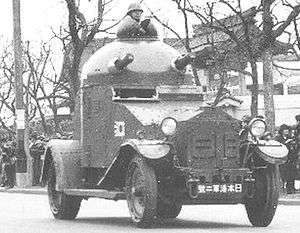Vickers Crossley Armoured Car
| Vickers Crossley Armoured Car | |
|---|---|
 IJN Vickers Crossley armoured car in Shanghai | |
| Place of origin | United Kingdom |
| Production history | |
| Designed | 1923 |
| Manufacturer | Crossley Motors |
| Produced | 1925[1] |
| Specifications | |
| Weight | 7.5 tons[1] |
| Length | 5.02 meters[2] |
| Width | 1.87 meters[2] |
| Height | 2.58 meters[2] |
| Crew | 5[1] |
|
| |
| Armor | 6 mm[1] |
Main armament | 2 X Vickers 7.7 mm MG[2] |
| Engine |
4 cylinder gasoline (petrol) 50 hp[1] |
| Speed | max 65 to 70 km/h[1][2] |

The Vickers Crossley Armoured Car a/k/a the Model 25 Vickers Crossley armoured car, was a British made military vehicle used by the British Army in India and exported to different countries, including Japan.
History and design
The Model 25 armoured car was a British designed and manufactured military vehicle, which the British Army used in India. The Model 25 was also exported. The Imperial Japanese Army (IJA) saw a need for increased mechanization, and the Kwantung Army began to import foreign-built vehicles, including the Model 25. The Kwantung Army used them during the Mukden Incident (Manchurian Incident), which was a staged event engineered by Japanese military personnel as a pretext for the Japanese invasion in 1931 of northeastern China, known as Manchuria.[3]
The Imperial Japanese Navy (IJN) also imported the Model 25 during the early 1930s for use in China.[4] The Model 25 was used specially by the Special Naval Landing Forces during the hostilities between Japanese military and the Chinese 19th Route Army in what became known as the January 28 Incident or Shanghai Incident in 1932.[1][4] The armoured cars were imported to strengthen the Japanese forces in and around the urban city and port area.[4]
The vehicle used riveted and welded armor with a thickness of 6 mm. It had an hemispherical turret, which mounted twin 7.7 mm water-cooled Vickers machine guns with a domed cupola. The engine produced 50 hp giving the vehicle a top speed of 65 to 70 km/h.[1][2]
Notes
References
- Duus, Peter (1989). The Cambridge History of Japan: The Twentieth Century. Cambridge University Press. ISBN 978-0-521-22357-7.
- Hara, Tomio (1973). Japanese Combat Cars, Light Tanks, and Tankettes. AFV Weapons Profile No. 54. Profile Publications Limited.
- Tomczyk, Andrzej (2002). Japanese Armor Vol. 1. AJ Press. ISBN 83-7237-097-4.